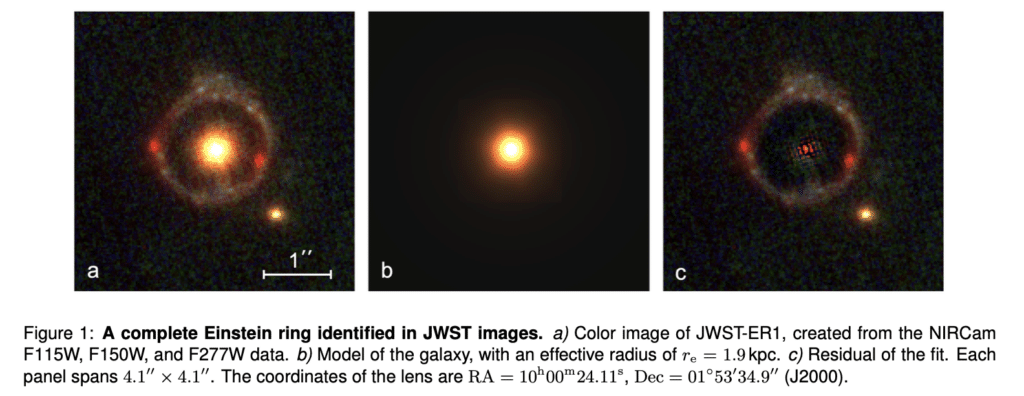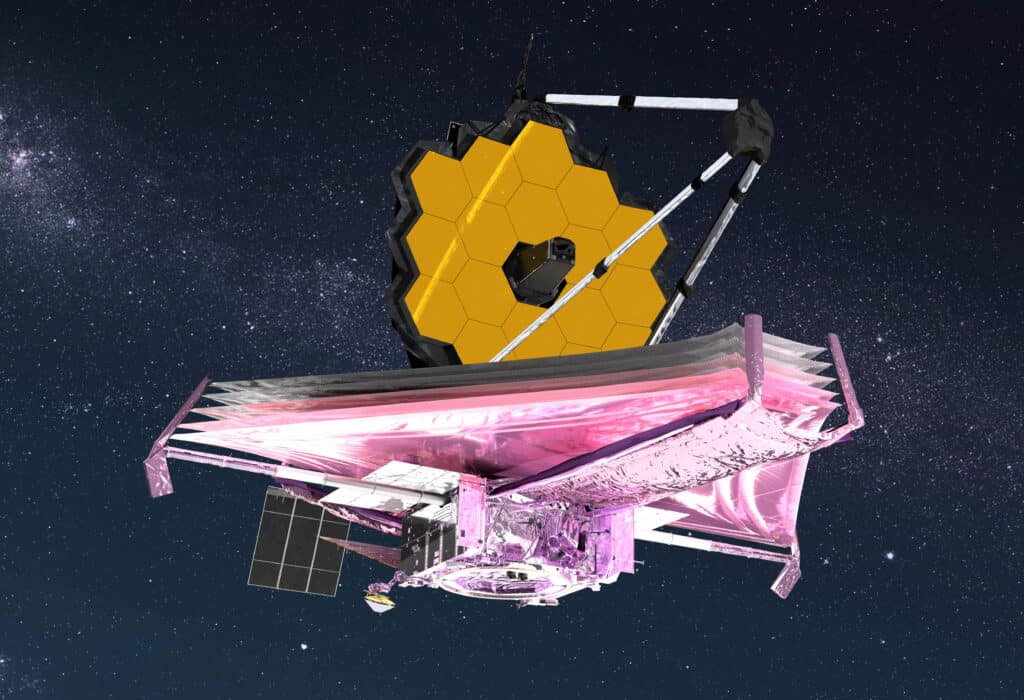A galactic oddity 10 billion light years away has astronomers scratching their heads. Dubbed JWST-ER1, this ancient galaxy was recently spotted by the James Webb Space Telescope, and it’s causing quite a stir. Why? Because it seems to be packed with way more invisible matter than anyone expected.
Galaxies like our own Milky Way are vast collections of stars, planets, gas, and dust. But there’s something else out there holding it all together — dark matter. This mysterious substance doesn’t emit, absorb or reflect light, making it impossible to detect directly. Yet its gravitational pull is so strong that it shapes the very structure of the universe.
Now, thanks to a cosmic quirk called gravitational lensing, astronomers from the University of California-Riverside have weighed the dark matter in JWST-ER1, which the Einstein ring is surprisingly associated with. And the results are staggering. This galaxy seems to have a dark matter “halo” that’s nearly six times more massive than all its stars combined! It’s like stumbling upon a cosmic elephant hidden in plain sight.
But here’s where things get really interesting. In a new study published in The Astrophysical Journal Letters, astrophysicists offer two competing explanations for this galactic conundrum. The first involves a theory called “cold dark matter”, or CDM for short. In this scenario, dark matter is made up of slow-moving particles that clump together over time. As a young galaxy pulls in gas to birth new stars, this process could also drag dark matter inwards, creating an ultra-dense halo.

“If we subtract the stellar mass from the total mass, we get the dark matter mass within the Einstein radius,” says study co-author Hai-Bo Yu, a professor of physics and astronomy at the University of California-Riverside, in a media release. “But the value for the dark matter mass seems higher than expected. This is puzzling. In our paper, we offer an explanation.”
The team’s simulations show that such a “contracted” CDM halo could indeed explain JWST-ER1’s beefy dark side. No need to invoke any new physics. But there’s another, more exotic possibility: self-interacting dark matter, or SIDM. Here, dark matter particles don’t just drift past each other like ghosts; they can collide and scatter. Over billions of years, this game of cosmic billiards could redistribute dark matter, changing the inner structure of a galaxy’s halo.
Researchers were intrigued after they found that SIDM models with a specific collision rate — roughly one collision per particle every 10 billion years — fit the JWST-ER1 observations to a tee. What’s more, this same SIDM scenario could potentially explain the dark matter patterns seen in much closer, more recent elliptical galaxies, without the need for a contracted halo. Two galactic puzzles, one elegant solution.
“When ordinary matter — pristine gas and stars — collapses and condenses into the dark matter halo of JWST-ER1g, it may be compressing the halo, leading to a high density,” explains study co-author author Demao Kong, a second-year graduate student at the University of California-Riverside, who led the analysis. “Our numerical studies show that this mechanism can explain the high dark matter density of JWST-ER1g — more dark matter mass in the same volume, resulting in higher density.”
But the plot thickens. Other studies have shown that to explain dark matter’s behavior on even smaller cosmic scales, like within dwarf galaxies, SIDM particles might need to collide far more frequently. This suggests that the true nature of dark matter could be stranger than either model alone — a chimera of sorts, with properties changing depending on a galaxy’s size and age. Clearly, there’s still much to learn about this cosmic ghost.
“This strong lensing object is unique because it has a perfect Einstein ring, from which we can obtain valuable information about the total mass within the Einstein radius, a critical step for testing dark matter properties,” notes study co-author Daneng Yang, a postdoctoral researcher at the University of California-Riverside.
As the James Webb Space Telescope peers ever deeper into the universe’s history, it will undoubtedly uncover more ancient galaxies like JWST-ER1. Each one offers a new window into dark matter’s secrets and a test for theories like CDM and SIDM. Whether the answer lies in a simple twist on established ideas or hints at entirely new physics, one thing is clear: the cosmos still has plenty of surprises in store. The hunt for dark matter’s true identity is only just beginning.












